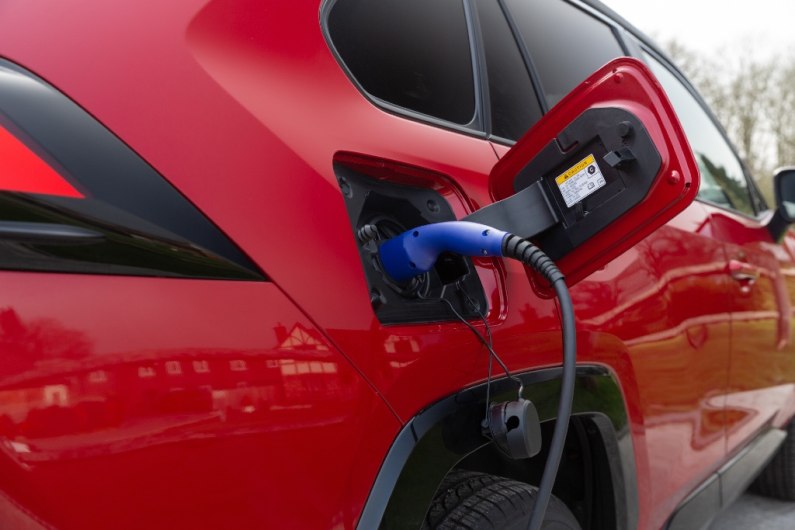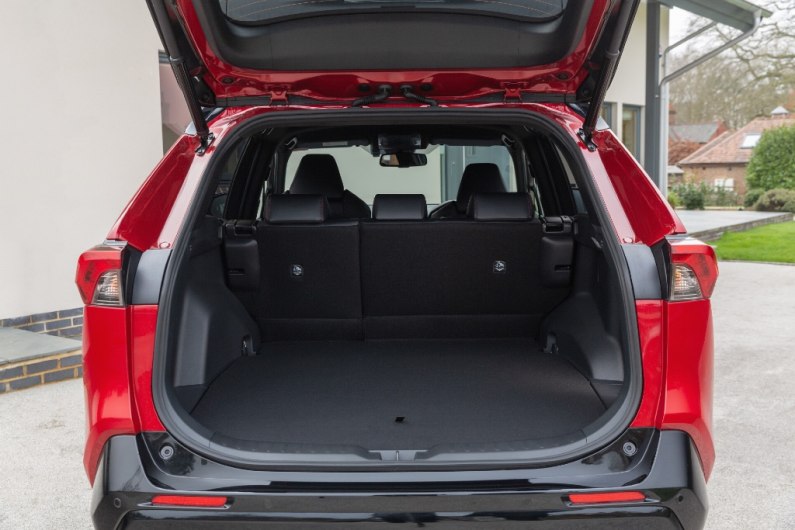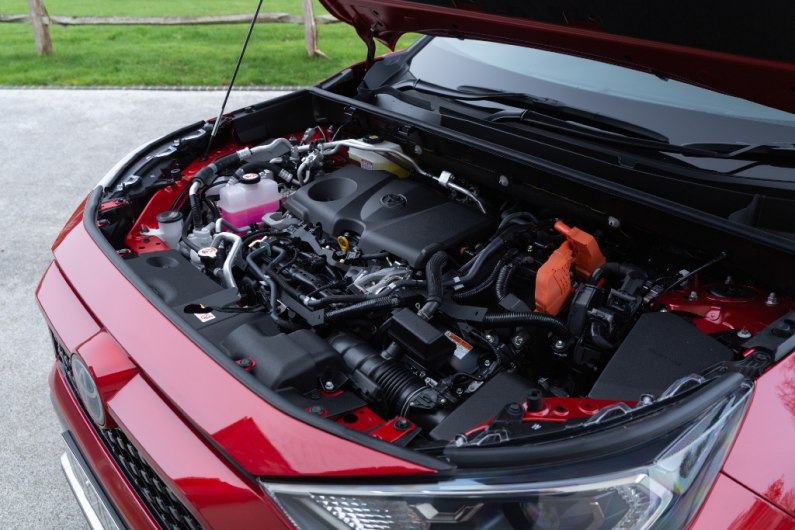
Toyota's hybrid SUV takes a step closer to full electrification with a new plug-in hybrid model. Is this now the RAV4 to own?
PROS:
+ Quiet and relaxing drive
+ Impressively brisk for an SUV
+ Up to 46 miles of EV range
CONS:
- Dated infotainment system
- You have to pay extra for a Type 2 charging cable
- Costly, starting at £46,495
Verdict: The Toyota RAV4 PHEV is an easy transition for anyone moving from the regular ‘self charging’ hybrid. It carries all of the model’s strengths in terms of practicality and a sense of durability, but adds blissful EV running and a surprising turn of pace. It becomes the default choice for potential RAV4 owners with somewhere to charge at home.
2021 Toyota RAV4 PHEV review: the five-minute read
The Toyota RAV4 is one of the most successful SUVs in the world. Over the decades it has acquired a reputation for being a hardy and dependable family car, and its transition into the world of hybridisation was a natural one considering Toyota’s history. The RAV4 takes another big step towards an electrified world with this new plug-in hybrid model.
It might look like a regular RAV4 with its chiselled silhouette, large grille and rakish lights, but it doesn’t take long to spot the excessive amounts of PHEV badging. Bling text aside, the RAV4 looks purposeful with enough character to stand out in the crowded world of statement-making SUVs. The fact that it looks identical to its siblings will appeal to those who either like the original design, or don’t need to continuously tell the world what they drive.

The interior does have some design flair with contrasting stitching and soft touch materials, but it’s more about form following function. Chunky door handles, rubber coated dials and hardy plastics are the order of the day. It’s not the most luxurious cabin in the class, but the fact you can operate the switchgear while wearing gloves has a utilitarian appeal. Less favourable is the 9-inch touchscreen that has the graphical capacity of Windows XP, however, it does support Apple CarPlay and Android Auto.
Rear passengers receive plenty of space to stretch out, and the boxy shape of the RAV4 means tall people or hat wearers are well accommodated. There is a modest transmission hump in the floor for the middle passenger, but it’s not really anything to write home about. While on the subject of practicality, boot space stands at 520 litres which is ample for family life. That said, it is 60 litres less than the standard RAV4.
The RAV4 PHEV is powered by a 2.5-litre petrol engine and a pair of electric motors for a punchy output of 302bhp – that’s hot hatch grunt in your family SUV. Despite the size and weight of this car, it’ll still crack 0-62mph in 6 seconds, although its top speed is a poultry 112mph. Its 18.4kWh battery grants up to 46 miles of pure EV range and can be charged in 7.5 hours via a three-pin plug, or 2.5 hours with a 7kW wallbox.

Some car manufacturers really struggle marrying an EV powertrain to a combustion engine. Noisy transitions and laggy power delivery can be expected, but not in the RAV4. You see, Toyota treat this car more like an EV supplemented by an engine, not the other way around, meaning that the engine only very rarely directly powers the wheels. The net result is blissfully quiet running with the engine only chiming in for maximum power or to serve as a generator to top up the battery. This symbiosis is buttery smooth, responsive and all rather impressive.
While the RAV4 PHEV might have hot hatch power, it’s obviously no sports car. Its additional battery weight and overall height counts against it through fast bends, but then that’s not what this car was really designed for in the first place. Regardless, the steering has a nice weight to it, allowing you to be precise with inputs. Low speed ride can be a bit brittle over high frequency bumps, but this does smooth out as momentum builds.
We were rather impressed with the Toyota RAV4 PHEV and to proves to a very competent all-round package. Sure, the occasional mooing from its CVT under hard acceleration and infotainment system that only just beats out an Etch A Sketch for graphical capabilities let it down, but as a vehicle this really is a very solid PHEV choice.
For great Toyota deals click here
Extended read…

2021 Toyota RAV4 PHEV interior and infotainment
As distinctive as the RAV4 can be on the outside, it’s inside where you’ll spend all of your time. There are certainly a few interesting design elements to the cabin, but its far more spright-laced than some rivals. Soft touch materials span the dashboard while some contrasting trim pieces help narrate things such as vents and the centre console. Prod around and you’ll find plenty of hard plastics in the cabin which could be argued aren’t befitting of something with this price tag. That said, the Toyota ethos of durability and function means that they will take the punishment of family life for many years.
You take up that desirable SUV high driving position to find there’s plenty of adjustment in the supportive seating and steering wheel, making getting comfy nice and easy. Ergonomically speaking, the cabin scores well with controls falling to hand with ease and plenty of little storage cubbies dotted about. We really like that the air conditioning controls remain physical, unlike many other cars that hide them within a touchscreen, and that the switchgear is purposely chunky for use with gloves.
The 9-inch infotainment system also retains some physical shortcut buttons which are great for use on the move. However, the software in play feels horribly dated with pixelated graphics and many menus. Thankfully, Apple CarPlay and Android Auto can be enabled when you plug in a smartphone.
One other digital gripe we had with the car was the 7-inch display within its instrument binnacle. It’s customisable with all sorts of driving data, but the speedometer is hard to read at a glance. The virtual needle has a blue glow to it, and the speedo itself doesn’t have 30 or 70mph marked. Ultimately you spend more time squinting at the very busy instrumentation than you’d like.

2021 Toyota RAV4 PHEV practicality and boot space
There’s plenty of space for all in the Toyota RAV4. Its big square windows serve to amplify the cabin’s airiness. Rear passenger enjoy good amounts of leg room and plenty of headroom thanks to the RAV4s practical shape. Even the transmission hump in the floor is flat enough to not bother the middle passenger.
With the addition of a larger battery, it’s maybe expected that the PHEV was going to lose a bit of boot space. However, 520 litres is still pretty big and will happily afford space for dogs and life’s other cargo. The boot aperture is wide and the flat floor is ideal when loading heavier items. There’s even some underfloor storage for cables. Our only niggle with the boot is the lack of hooks to prevent solitary bags from flying about the empty space.

2021 Toyota RAV4 PHEV engine and electric motors
Toyota are no strangers to hybrids, that’s for sure. In fact, it helped popularise them with the introduction of the original Prius, and now most Toyotas you can buy are hybrids. The new step on this road to electrification is a plug-in hybrid that offers a noteworthy EV range and can be topped up via a charger. The RAV4 PHEV incorporates a 18.1kWh battery and is capable of driving in a pure EV mode for up to 46 miles at speeds of 84mph.
That range means the average commute could be covered on electricity alone, saving you money and the environment in the process. Obviously Toyota’s claimed 282.5mpg and 22g/km CO2 depends upon how frequently you charge, but if you have a wallbox at home it might be some time before you hit the petrol pumps. While Toyota will make you pay extra for a Type 2 charging cable, its 2.5 hour charge time is more desirable than the 7.5 hours of a three-pin plug.
This is a very mature drivetrain, in that its EV, combustion and combined natures all blend rather seamlessly. The car’s pair of electric motors do most of the graft, while the engine only really kicks in to serve as a generator for the batteries. The only time this otherwise tranquil drive is interrupted is under hard acceleration, where the CVT with its constant revs makes an undesirable drone.
Combined, the total output of 302bhp makes this SUV faster than you’d expect, and the instant torque from the electric motors are ideal for getting out of junctions.

2021 Toyota RAV4 PHEV driving
No preamble, no build up. The RAV4 PHEV is simply a nice thing to live with. Around town its scale is diminished by sizeable door mirrors and good visibility – not to mention parking sensors and reversing cameras on appropriate trims. You can serenely potter about your business silently in EV Mode all day long, knowing that you’re doing the planet a favour and not spending money on petrol. This tranquility is only ever interrupted by a somewhat coarse low speed ride, or the CVT when a sudden burst of full throttle is needed.
It’s a similar story on the motorway where you can remain in a pure electric setting at cruising speed, although it’s hardly noticeable when the engine does decide to start topping up the battery or joining the battle in full. There’s some wind noise from the door mirrors, but overall the RAV4 is a lovely quiet place to cover distance. Well, that is unless you have a model with the excellent JBL sound system.
Dynamically speaking, it’s nice to have an SUV with respectable steering as opposed to something that’s overly light and wooly. There’s good weighting and inputs are met with precise outputs. There’s some body roll as you’ve expect with a big heavy SUV, but a strong sense of security in the chassis is reassuring. Despite having hot hatchback levels of straight line performance, its predictably less performance oriented through the bends – this is a big SUV with a hefty battery on board let us not forget. However, surging out of corners with the aid of all-wheel drive and electric motors remains amusing.
If you’re a business user the RAV4 PHEV is an obvious choice thanks to the potential fuel savings and BIK benefits. Private customers might have to think a little harder about that price tag as it is over £15k more costly than the entry ‘self-charging’ hybrid RAV4. That said, if you’ve got somewhere to plug your car in overnight, the PHEV is our RAV4 of choice.

